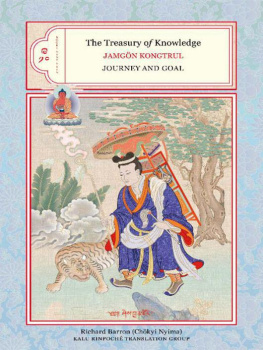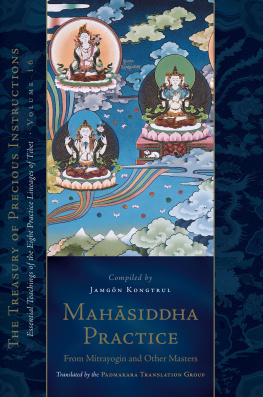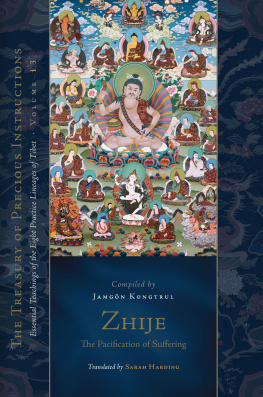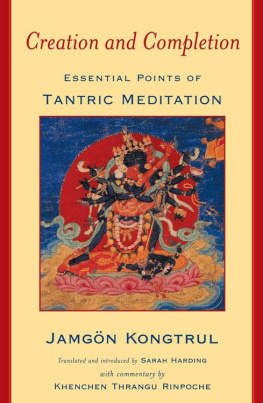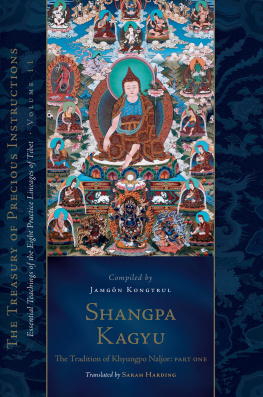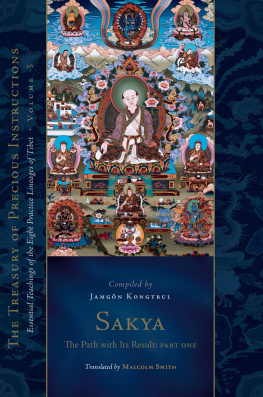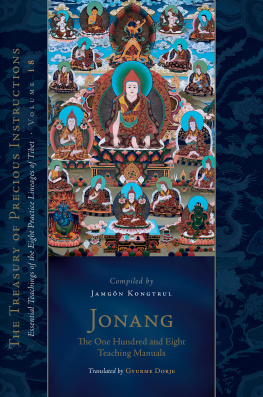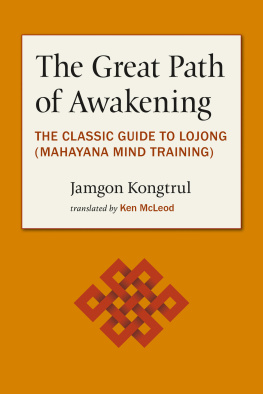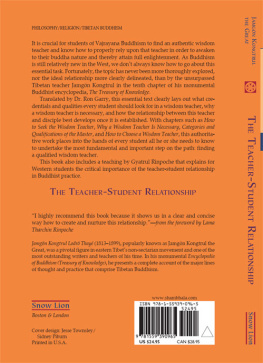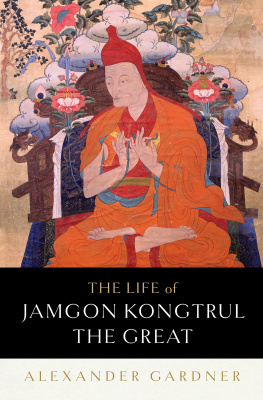

The translation and publication of this work have been made possible
through the generous support of the Tsadra Foundation.
Snow Lion Publications
P.O. Box 6483
Ithaca, New York 14851 USA
(607) 273-8519
www.snowlionpub.com
Copyright 2011 Kalu Rinpoch
All rights reserved. No portion of this book may be reproduced by any
means without prior written permission from the publisher.
Printed in USA on acid-free recycled paper.
ISBN 10: 1-55939-360-2
ISBN 13: 978-1-55939-360-7
Library of Congress Cataloging-in-Publication Data
Ko-sprul Blo-gros-mtha-yas, 1813-1899.
[es bya mtha yas pai rgya mtsho. English. Selections]
The treasury of knowledge. Books nine and ten: journey and goal:
an analysis of the spiritual paths and levels to be traversed and the consummate
fruition state / Jamgn Kongtrul Lodr Tay; Kalu Rinpoch Translation Group
under the direction of Khenpo Lodr Dny Rinpoch; this volume translated,
introduced, and annotated by Richard Barron (Chkyi Nyima).
p. cm.
Includes bibliographical references and index.
ISBN-13: 978-1-55939-360-7 (alk. paper)
ISBN-10: 1-55939-360-2 (alk. paper)
1. Ko-sprul Blo-gros-mtha-yas, 1813-1899. es bya kun khyab.
2. Lam-rim. I. Barron, Richard, 1952- II. Title.
BQ 7645.L35K66 2010
294.342042dc22
2010014388
The print edition of this work was designed and typeset by Gopa & Ted2, Inc.

B Y THE V ENERABLE K HENPO L ODR D NY
Jamgn Kongtrul Lodr Tay (18131899), whose coming was prophesied by the Victorious One, was a great master in the truest sense of the titlea master of the entire range of the Sages teachings, without any sectarian bias. His writings are contained in five collections known as the Five Great Treasuries , one of which is the Treasury of the Encompassment of All Knowledge . The subjects discussed in this work include Sanskrit grammar, valid cognition, the arts, medicine, poetics, etymology and synonymy, prosody, drama, and astrology, but most especially the text deals with the more extraordinary and inner fields of knowledge: the three ynas, the three aspects of ground, path, and fruition according to the older and newer schools of the secret mantra approach, and the three factors of view, meditation, and conduct. Its subject matter is thus the three higher trainings, while the treatment of these themes constitutes a summary of all the essential teachings of the Three Compilations, without exception.
This Treasury is a work that is entirely sufficient in itself. For those who wish to study, contemplate, and meditate on any and all of the general and specific mainstream scriptural sources (as well as all manner of spiritual advice and pith instructions) and thus explore these deeply without having to tire themselves by looking in many different sources, this work is an important, even indispensable, resource.
With this in mind, it was in 1988 that Kyabj Kalu Rinpoch founded the International Translation Committee (Dragyur Dzamling Kunkhyab) and convened many students and translators from countries in the Western hemisphere. It was on that occasion that work began on the English translation of The Treasury of Knowledge . With the passing of this great master, the unfinished work continued, and it fell to Kyabj Bokar Rinpoch to ensure that his glorious gurus intentions were realized. Bokar Rinpoch assumed this great responsibility and urged the translators involved to continue and bring it to a swift conclusion. Now the project is, for the most part, approaching completion.
The translator of this present volume, Lama Chkyi Nyima (Richard Barron), has undertaken to translate two of the books in this workBooks 9 and 10, which provide definitive discussions, respectively, of the developmental paths and levels, and of the ultimate fruition states, for both the cause-based dialectical approach and the older and newer schools of the secret mantra approach. This translation is published under the auspices of the Tsadra Foundation.
I wish to express my heartfelt thanks and appreciation to both the translator and the sponsors for their efforts, and add to this my most sincere aspirations. I pray that this noble undertaking will contribute to the alleviation of all degeneration taking place, externally and internally, for all beings in general and for this world in particularthat is, all illness, famine, war, and strife, and all harm caused by the four elements; to the ongoing glory of undying love, peace, and well-being; and ultimately, to the attainment of the precious state of omniscience and complete enlightenment!
Khenpo Lodr Dny
February 23, 2007
While it has been the convention among Western scholars to consider 1899 to be the year of Kongtruls death, the account of his death and funeral by his student Nesar Karma Tashi Chphel states that Kongtrul passed away on the evening of the twenty-seventh day of the eleventh month of the Earth Pig Year. Given that the Tibetan year overlaps the Western year by at least one and a half months, Kongtruls death would have occurred sometime in early January of 1900. See Kongtrul, The Autobiography of Jamgn Kongtrul , 403, n. 30.
T RANSLATORS I NTRODUCTION
More important than practicing the dharma is the way one practices.
( chos sgrub pa las sgrub tshul gtso )
TIBETAN SAYING
This volume is part of the ongoing project founded by the Very Venerable Kalu Rinpoch (19051989) to produce an English translation of the Treasury of Knowledge , a monumental work in ten major sections by Jamgn Kongtrul Lodr Tay (18131900), of whom Kalu Rinpoch is held to have been the activity emanation. The present volume contains a translation of the last two of the ten books that constitute Kongtruls masterful exposition of the entire range of thought and practice available within the Tibetan tradition of Buddhism, as well as the concluding section of the entire Treasury and a verse summary of it written by Kongtrul himself as a mnemonic device for his students. In Book 9, Kongtrul discusses the journey (the process of transformation) from varying perspectives within the Buddhist tradition, while in Book 10 he presents the goal (the fruition state of enlightenment to which this leads).
Every systematized school of thought, secular or sacred, has its mind map, a model for defining what is, in effect, a journey. Whether such a map is explicitly described or only implicitly understood, it presents an overview of the process by which the mind of the individual is shaped or transformed by that system, and so undergoes a journey, moving from one worldview, one set of values and assumptions and perceptions, to another. The Buddhist teachings are not unique in referring to this process as a path, and they present a very sophisticated and logical model of the progress ordinary individuals make from states of confusion and frustration to those of liberation and enlightenment. There are multiple models, for Kongtruls intention was not to present a single interpretation of how this path unfolds and leads to its goal but instead to expose his readership to the entire spectrum of possibilities available to him as a master of the Tibetan tradition of Buddhism in all its diversity. It is a well-recognized fact in the Buddhist tradition that beings are of many different personality types and levels of aptitude, and that it is necessary to accommodate the needs and predispositions of a wide spectrum of individuals, rather than try to define a single, fixed model into which everyone must somehow fit.

